#ultimately in his mind while marty was the one who personally and actively changed his family's history
Explore tagged Tumblr posts
Text
Also, unrelated because now I'm just thinking about it—I imagine Marty fading out of existence had to be super painful. Like it's a horrifying, harrowing experience, and in the film even though the camera is only on him for a few seconds during the George / Lorraine moment, he looks incredibly pained. Which makes sense, I mean; he's probably losing his senses, his control over his body more and more as the seconds go, everything's just collapsing until that moment where there's nothing, not even a memory.
That deleted scene from pt.2 with Old Biff definitely supports that but it also looks like it insinuates that the ripples in time will catch up and effect a person based on how they're removed from the timeline. He fades out in a way that alludes to the fact that Lorraine shot him well before he could ever make it to that age.
#IT'S SO DARK#and in my continued (mis)adventures and such for the time-travellers doc has also experienced something like this#they've accidentally changed the course of their lives several times - fixed it but still#&; there's something about that one 「 ooc 」#&; a great idea can change the world 「 hc 」#i'm sure marty's told him about it at some point and doc definitely feels bad over that#ultimately in his mind while marty was the one who personally and actively changed his family's history#doc harbours personal blame for that because apparently he didn't take proper enough precautions (though could he really have stealing from#terrorists? no. not without heavy government intervention) when doing something as incredibly dangerous as getting himself involved with#them. yes good intentions and all and also the fact that this was literally all he needed - there was the end of the dream so close - but#still; it was his actions that sent this all into motion - that killed him that night - that sent marty back#fja;sdlkf;j anyway
7 notes
·
View notes
Text
An Examination of Joss Whedon
On February 11th, Charisma Carpenter made a post on her Instagram account detailing mistreatment she experienced on the sets of Angel and Buffy the Vampire Slayer. Carpenter worked on both shows from 1996 to 2004 and attributes this mistreatment to show creator Joss Whedon.
On the same day, I made a post on my Tumblr and my WordPress accounts regarding my stance on this topic. I felt it was important for me to post something quickly due to the large number of Buffyverse followers and mutuals on my Tumblr.
I was overwhelmed by the likes, reblogs, and comments this post received in less than twenty-four hours. I’m so glad so many people support Charisma Carpenter and others who are speaking out about their experiences.
Workplace mistreatment is insidious, and too often the systems in place to mediate these situations are designed to protect the employer rather than the person experiencing mistreatment. This happens everywhere in every industry. When people in the public eye draw attention to these issues it helps bring awareness to everyone and encourages societal change.
In today’s climate, social media moves faster than legal or internal HR systems. This means, more often than not, accusations spread, opinions form, and action is taken long before any investigation can occur. Because of this, it’s important for people to seek out the facts themselves in order to stay informed or make decisions about who in fandom they choose to support or not.
I’m going to go through various tid-bits I’ve seen over the past twenty-five years regarding Joss Whedon’s behavior, which prompted my quick response to Charisma Carpenter’s post. I feel it’s important to share this with those who may be new to the fandom, or those who doubt Charisma Carpenter’s claims and those of others.
The Bronze
Before there was Twitter, there was The Bronze.
The Bronze was the official online gathering place of Buffyverse fans. Joss Whedon and others involved with the shows occasionally popped in and posted, interacting with the fans. There was speculation about the trajectory of the show, discussion about lore, fan theories, and behind the scenes rumors.
I didn’t learn about these forums until I was in high school (from 2002 to 2006) and I never posted. I just read up on the fun factoids I could find. I wasn’t a heavy Internet user back then. We had one computer in my house and it was shared with my parents. I was only allowed on for so much time per day, yada yada.
I think Buffy the Vampire Slayer was one of the first shows – if not the first – to utilize this kind of creator/fan interaction. It wasn’t a regular thing back then.
The vibe of these forums was very laidback. When someone directly involved with Buffy the Vampire Slayer or Angel posted (known as a V.I.P.) it was with a very casual, unmoderated tone. There was no screenshotting every word to be saved for later. Someone from the media couldn’t grab a comment made and spread it across the Internet in real time. There were mailing lists – collections of email addresses for people who wanted updates on show spoilers or particular non-show activities of various actors. Fan letters were still a thing – actual snail mail letters you could send to actors and writers of the shows. Things moved slowly, and there wasn’t as much transparency as there is on the Internet today with sites like Instagram and Twitter.
In a series of posts made on November 6th, 2001, Joss Whedon reacted to the airing of the musical episode, “Once More with Feeling.” He called it “the biggest undertaking of my life,” but expressed his appreciation toward the UPN network, the cast, and crew – particularly Anthony Head, Amber Benson, and James Marsters. He calls Anthony Head “the golden throat” and writes of James Marsters, “And James, who always tells me to do everything I dream of, then brings that intense voice and those cheekbones along for the ride.”
All he writes about Amber Benson is, “Amber… just, you know… Amber….”
Alarmingly absent from his praise is star Sarah Michelle Gellar, who “went back and forth” over whether or not to sing in the episode. “I’m not a singer,” she told EW. She didn’t feel prepared enough and “didn’t feel confident.” As someone who broke out of her comfort zone and pulled off a wonderful leading performance, Gellar was certainly deserving of some acknowledgment.
Seemingly realizing he neglected to mention Marti Noxon, Whedon tacked on, “Do you know anyone that hot who can run a show? Do you? I don’t think so. What a voice.” At the time, alongside comments about James Marsters’ cheekbones and being “a little gay” for Anthony Head, this seemed to be an attempt at an edgy complement (though a little cringey). Marti Noxon was a new showrunner for Buffy, taking over for Joss. Referring to her as hot rather than praising her work is a little demeaning, in my opinion, particularly when it was up to him to make sure she was respected and taken seriously in filling his shoes.
On May 22nd, 2002, Whedon posted about “the gay thing” – probably not for the first time. Regarding some fan reactions to the death of Tara Maclay, Joss wrote, “I knew some people would be angry with me for destroying the only gay couple on the show, but the idea that I COULDN’T kill Tara because she was gay is as offensive to me as the idea that I DID kill her because she was gay. Willow’s story was not about being gay. It was about weakness, addiction, loss… the way life hits you in the gut right when you think you’re back on your feet.”
Keep in mind, at the time, Willow was one of the first gay main characters – if not THE first – on a major primetime show in the sci-fi/fantasy genre. Having a gay couple on a major show like this was not a regular thing, which made the shocking death of Tara and the dark turn of Willow particularly hard-hitting. While Whedon isn’t saying anything particularly inflammatory here, it does show a sort of crass attitude toward the removal of this representation from the show, which had become so important to so many fans – and still is now.
There’s not a lot of meaty information to be found that I could dig up, but I wanted to give people an idea of this landscape back in the day. I picked out those particular Joss Whedon posts because they show a very casual disregard for the women involved in the shows – an insidious and subtle thing, but it’s there.
Fighting with Buffy
Jeff Pruitt was a stunt coordinator on Buffy the Vampire Slayer from 1997 to 2000. He also happened to be romantically involved with Sarah Michelle Gellar’s stunt double, Sophia Crawford. Both would exit the show by its fifth season. According to Pruitt, it was not an amicable exit.
Pruitt claims he and Crawford were treated badly on the set, that Crawford was “one never ending injury” and she had “reached the end of her rope.” He said that they were threatened and blackballed when they made attempts to leave before the 100th episode. They got an opportunity to work on Dark Angel, but the people at Dark Angel supposedly received a phone call from “someone high up at their studio” and were told not to hire Pruitt and Crawford. He suspects this was to keep Sophia Crawford from leaving Buffy the Vampire Slayer.
Their firing was unceremonious, according to Pruitt. “Sophia was told point blank that she was being fired because she knew too much about things,” he claimed. He said Joss Whedon and Jane Espenson threatened Crawford, saying if she spoke about what happened on set she’d “never work in this town again.”
Jeff Pruitt spoke about “sneaky politics” behind the scenes, saying “there was something weird going on” in the months leading up to his and Crawford’s exit. Pruitt claims Sarah Michelle Gellar was a “spoiled starlett” and that she was “out to get” him and Crawford. He attributes statements he made in private emails that were later read by Joss Whedon to his firing.
It’s worth noting that many people have stated that Sarah Michelle Gellar is undeserving of a “diva” label. When asked in 2004 what it was like working with Sarah Michelle Gellar, Julie Benz said, “She’s extremely talented and generous. Her reputation is just completely untrue. Unfortunately in Hollywood if you’re young and female and you have an opinion you get labeled a diva or something…else. Sarah’s an amazing talent, but she got labeled.”
In a 2013 interview on Bravo’s Watch What Happens Live, Alyson Hannigan answered a series of rapid-fire questions about Buffy the Vampire Slayer. When asked who was the most “annoyed” by the end of the show, she said, “Sarah,” referring to Sarah Michelle Gellar. When the audience booed, Hannigan clarified, “Well, she had a big career going, and it was a lot of work.” When asked when Gellar started to “hate” the show, Hannigan quickly said season three. In a later interview for Huffpost Live, Hannigan clarified her comments further. “[Sarah Michelle Gellar] worked her butt off,” she stated. “She worked eighteen-hour days for years.” Hannigan said she wouldn’t have classified Gellar as “annoyed,” saying, “she was super professional.”
Honestly, I’m Team Sarah on this one. I couldn’t find corroborating sources for Jeff Pruitt’s claims of her “diva” behavior, but I found several sources stating otherwise. Gellar did confirm during a cast reunion that she may have oversold her stunt experience, which ultimately would have meant more work for her stunt double and the stunt coordinator. It seems to me like this set everything on a bad foot with that team. But, the reasons Jeff Pruitt and Sophia Crawford gave for their exit had little-to-nothing to do with Gellar.
Vincent Kartheiser
Vincent Kartheiser played Connor on Angel, and he did a number of interviews talking about his experience on the show. I picked his interviews because I’ve always found him to be very candid and he doesn’t seem to shy away from uncomfortable answers to questions. A few of his answers provide a little insight into the mood on the set at times, and Charisma Carpenter’s attitude.
When Charisma Carpenter was pregnant on the show, she had a storyline that heavily involved Connor, so the two spent a lot of time working together on set. He was asked about her pregnancy and how it affected filming. In a 2003 interview for BBC Cult, Kartheiser said of Carpenter, “she was a great sport and would suck up the pain even though you could see that she was in it.”
In another interview for Angel Magazine from the same year, he said Carpenter had “an abundance of energy for a working, pregnant lady who, right in the heart of her pregnancy, they put her in so much.”
It’s worth noting Vincent Kartheiser had his own issues with the show. “What really made me interested in Angel was the idea that as a show, it changed so much and all the characters could change so much,” he told Angel Magazine. “It wasn’t that clichéd kind of ‘show up, do your thing, go home’ all the time.” Unfortunately, the potential that interested him never came to fruition for his character. “As the season went on, we never really got to deal with the relationship problems between me and David,” Kartheiser said, referring to David Boreanaz as Angel. “I never really got the opportunity to bond with any other characters.” He expressed a feeling that there was nowhere for his character to go and that Connor’s motivations seemed to change from week to week. “There were parts of the season I didn’t have the opportunity to stretch,” he explained, “that it felt like I was doing the same scene over and over.”
Vincent Kartheiser did a later interview with Giantmag.com where he reiterated some of these frustrations. For him, the character of Connor started to get stale early on. “Every week I’d show up and have a scene with Cordelia,” he said, “then Angel would show up and I’d have some sort of conflict with him. There’d be a couple of fight scenes where I’d fight with them even though I didn’t want to and then I would sulk and leave. That to me was every episode.” He felt the writers had written Connor “into a corner” and that fans responded poorly to him.
When comparing his experience on Angel to his experience playing Pete Campbell on Mad Men, Kartheiser expressed a lackluster feeling on the set of Angel. “There was a real sense on Angel that people were just doing a job,” Kartheiser said of the set. “The grips, the DP, even the directors would kind of just show up, do their job and go home.” This atmosphere is a direct contrast to what had attracted Vincent Kartheiser to the show in the first place. “On Mad Men we also have Matthew Weiner on set all the time whereas Joss [Whedon] was hardly ever on Angel,” Kartheiser explained. “I think Joss was doing Firefly at that point and was in love with his next project. I had a friend who filmed a few episodes in the first season of Angel and said everyone was invested and there was crazy energy, so maybe I just came into it late.”
Kartheiser also delved deeper into his frustrations over the direction (or lack thereof) of his character. “I let them know right off the bat that some of the choices they were making [about Conner] were wrong,” he said. “I showed up to play that character and I had a lot of ideas. And they didn’t like any of those ideas.” As a result, Kartheiser said he got “jaded” and “angry” at the show. “I felt like it wasn’t a collaboration, that the people I was working with didn’t care to take risks.”
In hindsight, he went on to say, “I was never a fan of Buffy, I’ll say it straight out. I was never a fan of Angel. I always found it hard to say Joss’ words.”
From all these comments, both from the beginning of Vincent Kartheiser’s journey as Connor, and from a few years after the show ended, it seems like he was excited for the opportunity, but ultimately disappointed with the overall experience. He also revealed how uncomfortable Charisma Carpenter had to be during filming while she was pregnant, but noted her energy and attitude were never a problem.
Farewell Cordelia
Prior to Charisma Carpenter’s official exit from Angel, her character arc had taken a very strange turn and Cordelia had been ominously left in a coma. Concern grew when Charisma Carpenter was not included in the cast of season 5. In a 2003 interview with TV Guide Online, Joss Whedon stated, “The Angel/Cordelia [love story] had gone pretty much as far as we wanted to take it” and that it wasn’t popular with the fans. “It just seemed like a good time for certain people to move on,” he continued. “Not completely, obviously. I’m hoping that we’ll get Charisma to do some episodes as Cordelia sometime during the year.”
TV Guide asked, “Isn’t that a disservice to fans who invested all those years in the character and her redemption? It seems an odd thing to do to the show’s leading lady.” Whedon responded, “That’s a fluctuating concept, the leading lady thing. And it is a little odd. Some choices are ultimately kind of controversial about who stays and who goes and who we focus on. But obviously, we had to have her out of a bunch of episodes toward the end of the year because she was having a baby… so what we had [leading] up to it wasn’t a dynamic I wanted to play out that much.” When asked if things were left on good terms with Charisma Carpenter, Joss Whedon stated he wouldn’t discuss that in an interview.
From Charisma Carpenter’s perspective, she was uncomfortable with Cordelia’s storyline prior to her coma and her death. “It was creepy,” she said of Cordelia’s relationship with Connor. “Connor was Angel’s son and half my age.” Carpenter stated it was important for her to return to wrap up the character’s storyline. “We didn’t want to just leave Cordelia in a coma,” she stated. “Whatever happens after this, I’m open. But it’s just best this story be [resolved] now. Otherwise, it’s a disservice to the fans of our show.” When pressed regarding whether or not she’d return to the show, Carpenter replied, “I don’t think it’ll be necessary. You never say never. However, at this point in time, I don’t see a future for her.” She continued with, “I feel like Joss feels – the Cordelia stories have been told. There were no other directions to go with her.”
Carpenter’s final appearance as Cordelia was an emotional experience. “We’ve been crying for the last two days,” she said in a behind-the-scenes interview. “I’m so physically drained.” She wasn’t the only one affected, either. “The director was crying, the crew was crying, we were crying,” she said. She called it a sad goodbye personally, professionally, and story-wise.
Working with Joss Whedon
Over the years, Joss Whedon gained a reputation for being unconventional to work with. Many actors from the Buffyverse have said they were unhappy with their characters’ creative paths. Sarah Michelle Gellar felt season six “betrayed” who Buffy was, saying she had to be “talked off a ledge” a number of times during filming.
Nicholas Brendon felt the character of Xander was “underrated,” particularly during season seven. “Joss did have a talk with Sarah and I because he was kind of contemplating the idea of Xander and Buffy ending up together at the end of season seven,” Brendon told AV Club. “We were both for it, but then that never came to fruition and I lost my eye.”
On an episode of Michael Rosenbaum’s Inside of You podcast, James Marsters said he was “terrified” of Joss Whedon. “I wasn’t designed to be a romantic character,” he explained. “The audience reacted that way to it. And I remember [Joss Whedon] backed me up against a wall one day, and he was just like, ‘I don’t care how popular you are, kid. You’re dead! You hear me? You’re dead! Dead!” Rosenbaum asked, “Was he kidding around?” and Marsters replied, “No. Hell, no.” Marsters also said he had “open wounds” on his scalp from over-using bleach on his roots every eight days to keep the roots from growing out.
Multiple actors from Angel have talked about Whedon’s habit of making actors squirm. David Boreanaz spoke about how he learned about the Angel spinoff during a twentieth anniversary cast reunion. “I got a phone call that Joss wanted to talk to me,” Boreanaz recalled. “The only thing he said was, ‘I want you to come into my office tomorrow,’ and I’m like, ‘I’m fired.’” He described having a night of “angst” and spent the following day working on some flashback scenes. When he finally met with Whedon at lunch it took some time for Whedon to tell him his character was getting a spin-off. Alexis Denisof expressed a similar knee-jerk feeling of “uh-oh,” but had an idea the spin-off was filming. However, Amy Acker had a similar story to what Boreanaz experienced when she was told about her character Fred’s transformation into Illyria. “It seems to be an echo of, like, ‘Hey, can you meet me for coffee tomorrow?’ and I’m like, ‘Ohh, they’re firing me!’ And we sat down to coffee and he said, ‘I just wanted you to know I’m killing Fred.’ And he waited, like, really a long time.” Charisma Carpenter chimed in, “He likes to do that!” Acker was then informed she would still be on the show as Illyria.
Charisma Carpenter and Marti Noxon have shared their own stories about Joss’s “You’re fired, just kidding” stories. Seth Green quipped “He did that to me too, but it took.”
Whedon’s View of Women
While Joss Whedon considers his writing to be feminist, his portrayal of women as well as other statements he’s made contradict this. In 2013, he gave a speech for Equality Now about his dislike of the word “feminist.” While this speech earned him some acclaim, it also earned him some backlash from the feminist community. This was mainly because he claimed it’s natural for people to be equal, and to add “-ist” to the end of the word “feminist” implies that people’s natural state is to be unequal. This stance was seen as disrespectful to Feminism as a movement, for some.
Joss Whedon received wide criticism for his portrayal of women in the Marvel Cinematic Universe. One critic, Scott Mendelson, talked about Whedon’s portrayal of Scarlet Witch and Black Widow in Avengers: Age of Ultron. “Scarlet Witch eventually has to be coaxed into bravery by one of the male heroes,” Mendelson writes of Elizabeth’s Olson’s character. Mendelson was even less thrilled with Scarlet Johansson’s Natasha Romanoff. “Maybe I shouldn’t be annoyed that the only major female character’s primary arc is a theoretically unrequited pining for a nice guy with major anger issues,” he writes, “or that said character briefly gets captured by the villain in the second act and tossed in a cage for no reason other than to be rescued by her male compatriots.” Backlash over this film caused Whedon to quit Twitter. In an article for Gizmodo, writers Meredith Woerner and Katharine Trendacosta point out that Joss Whedon teased a “killer” backstory for Natasha Romanoff. “Instead of an assassin constantly struggling with finding moral lines she didn’t know existed, we got a woman who feels incomplete because she cannot have babies,” Woerner and Trendacosta concluded.
In 2017, Whedon’s ex-wife Kai Cole wrote a blog for The Wrap stating, “he used his relationship with me as a shield, both during and after our marriage, so no one would question his relationships with other women or scrutinize his writing as anything other than feminist.”
Cole alleges Whedon wrote her a letter in which he said, “When I was running ‘Buffy,’ I was surrounded by beautiful, needy, aggressive young women… As a guilty man I knew the only way to hide was to act as though I were righteous… In many ways I was the HEIGHT of normal, in this culture. We’re taught to be providers and companions and at the same time, to conquer and acquire — specifically sexually — and I was pulling off both!” At the end of her essay, Cole wrote, “I want the people who worship him to know he is human, and the organizations giving him awards for his feminist work, to think twice in the future about honoring a man who does not practice what he preaches.”
In response to Kai Cole’s letter, Laura M. Browning wrote in an AV Club article, “I was sad, but not shocked—maybe a little embarrassed I hadn’t looked more closely at some very clear problems in his work… His work has plenty of male gaze and women in refrigerators and some narratively pointless rape scenes—it’s all right there, in hundreds of hours of television and film—but boy, it sure is a lot more comfortable to listen to a guy tell you he’s a feminist than listen to a lot of women telling you he’s not.”
Whedon’s veneer of feminism has been cracking for several years.
Recent Allegations
Actor Ray Fisher claimed Joss Whedon behaved inappropriately on the set of Justice League, tweeting, “Joss Wheadon’s on-set treatment of the cast and crew of Justice League was gross, abusive, unprofessional, and completely unacceptable.” Fisher also accused Geoff Johns and Jon Berg of enabling Whedon’s behavior. An investigation was done by Warner Brothers and co-stars Jason Mamoa and Kiersey Clemons publicly supported Fisher. Ultimately, the investigation concluded and “remedial action” was taken. The action taken has not been specified.
Shortly after, Joss Whedon exited the HBO series The Nevers, which Fisher attributes to his own claims.
Team Charisma
Those who have shown support to Charisma Carpenter include: Sarah Michelle Gellar Ray Fisher J. August Richards Michelle Trachtenberg Amber Benson Eliza Dushku Jose Molina Marti Noxon Emma Caulfield James Marsters Anthony Head Clare Kramer James C. Leary Sophia Crawford David Boreanaz Amy Acker Julie Benz Danny Strong Adam Busch Tom Lenk Nicholas Brendon Jeff Mariotte
Others who have written about Joss Whedon or come out to support those coming forward:
Courtney Enlow Nell Scovell Glen Mazzara
My Conclusion
As I stated in my previous post on this topic, I stand with Team Charisma. It is not okay for a person in a position of power over others in the workplace to misuse that power in an inappropriate or abusive manner. No matter how talented that person may be and how beloved the work may be.
49 notes
·
View notes
Text
Kellogg’s Breakfast Revolution
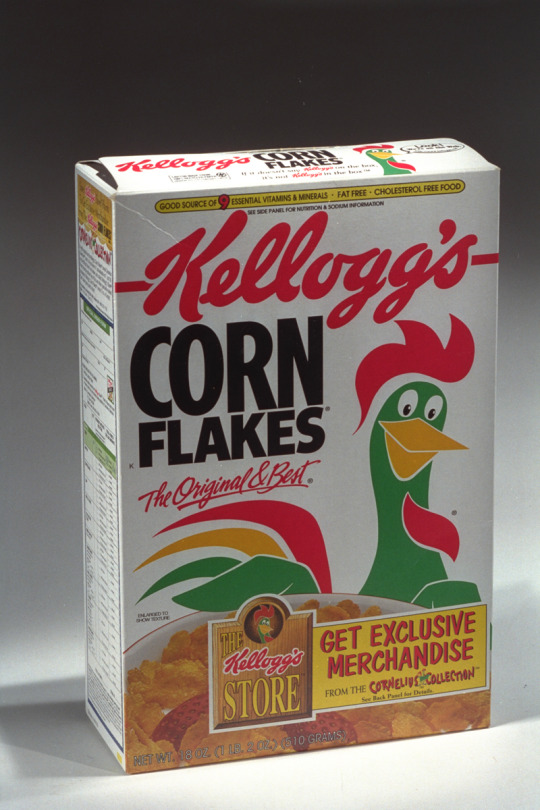
This 1995 Kellogg’s Corn Flakes box (96.34.3.13) features Cornelius Rooster, a popular character logo since the late 1950s. THF302682 Perhaps it could only happen in western Michigan: the combination of religious fervor, fertile soil to grow grains that could be transformed into easily digestible breakfast cereals, and the spirit that one could accomplish anything with hard work and determination. Out of this world came John Harvey (J.H.) and William Keith (W.K.) Kellogg—two brothers who would transform the way that Americans ate breakfast. They were, unfortunately, often at odds. And they didn’t work alone. But, through their persistence and combined efforts, the dry cereal flakes they perfected would start a breakfast revolution. Into the early 20th century, the American breakfast was often heavy, starchy, salty, and fatty—laden with leftovers from last night’s dinner, like cured meats, day-old biscuits, and lard-fried potatoes. No wonder that one of the most common complaints of the time was “dyspepsia”—a term that applied to a medley of stomach ailments, including constipation, diarrhea, heartburn, and indigestion. For the sick and the elderly, lengthy cooking of porridges or gruels was the only morning-meal alternative.
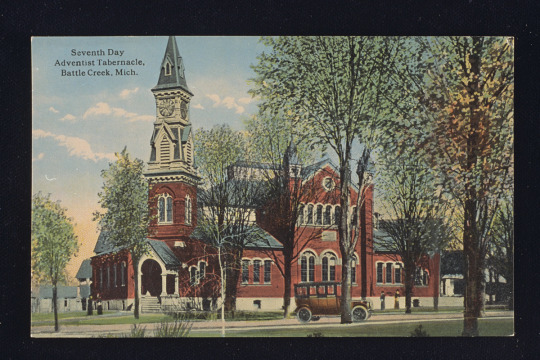
Seventh-day Adventist Tabernacle, Battle Creek, Michigan, 1914 (99.146.39). THF316219 The Kellogg brothers—John Harvey (1852-1943) and his younger brother Will Keith (1860-1951)—grew up in the close-knit community of Battle Creek, Michigan, a center for the Seventh-day Adventist Church. Members of this homegrown Christian religious sect not only believed in the connection between spiritual and physical health, but also that healthy living depended upon maintaining a nutritious vegetable- and grain-based diet. Seventh-day Adventist leaders Ellen and James White hand-picked J.H. Kellogg to run their medical and health programs in Battle Creek, and ultimately sent him to the prestigious Bellevue Hospital Medical College in New York City. It was during his morning rush to classes at Bellevue that he began thinking about creating a nutritious, ready-to-eat cereal.

In 1888, Dr. John Harvey Kellogg authored this book (29.1119.14), aimed at explaining to young people, “in clear and simple language,” the structure and functions of the human body as well as his personal philosophy for healthful living. THF183317 Upon returning to Battle Creek in 1876, Dr. J.H. Kellogg assumed leadership of the Whites’ Western Health Reform Institute. But his vision was much larger than theirs, ultimately leading to his breaking ties with his Seventh-day Adventist backers. With the able (but underappreciated) assistance of his brother, Will, to run the business end of things, Dr. Kellogg turned the Whites’ once-modest institution into the grand Battle Creek Sanitarium. Nicknamed the San, this “university of health” would become a world-famous health resort, catering to the rich and famous (including Henry Ford) as well as the truly ill. At the San, Dr. Kellogg would profess and put into practice his long-held philosophy of “biologic living”—that is, the belief that correct eating and drinking, plenty of exercise, hydrotherapy, and the abstinence of tobacco would lead to a healthy mind, body, and spirit.

Corn Flakes loom large in this postcard (94.82.4) showing the packing room at the Kellogg’s plant, about 1935. THF320131 The true origin of corn flakes is difficult to trace, as competing versions of it have been offered by Dr. Kellogg’s wife Ella (whose dedicated assistance was integral to the San’s food operations), his brother Will, other family members, and San employees. All agree, however, that it started with Dr. Kellogg’s correct hypothesis that a grain-based cereal would be easier to digest if the grain’s starch was broken down through a pre-cooking process. (Ironically, nutritionists now agree that easy digestibility is less healthful than the slower-to-digest high-fiber cereals that are so popular today.) Hours of experimentation and a little accidental fermentation finally led to the creation of an easily digestible flaked cereal made of wheat. Patients at the San loved it and mail-order demand (usually by former patients) soon exceeded supply. Dr. Kellogg felt that he had accomplished what he had set out to do.
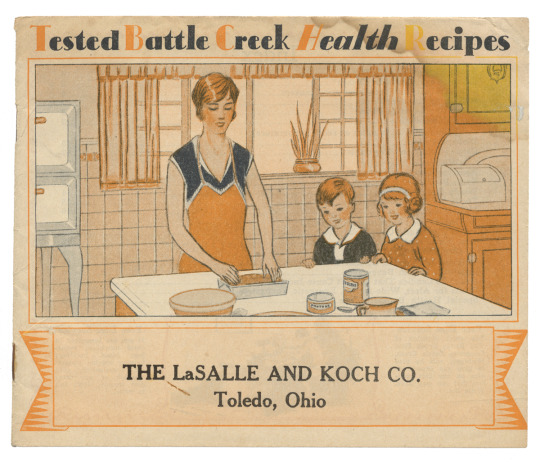
Recipes for health foods that Dr. J.H. Kellogg served his patients at the San were featured in this 1928 booklet (95.174.22) aimed at the general public. THF17004 But his younger brother Will was far from done. Will saw a raft of competitors scrambling to introduce their own—often very similar—flaked breakfast cereals and making money off of their original idea. Whereas his brother, the doctor, was satisfied with continuing to produce healthy, nutritious foods for his niche group of patients, Will saw an opportunity to market a light, healthy breakfast cereal to a much larger public. After helping his brother rebuild the San following a devastating fire in 1902, he bought the rights to the flaked cereal and struck out on his own. Will immediately made some changes to the initial cereal his brother was serving at the San. He replaced the wheat with cheap, plentiful, better-tasting corn, and added (to his brother’s horror) malt, sugar, and salt to make the cereal more palatable to the general public. In 1906, Will Kellogg founded the Battle Creek Toasted Corn Flake Company and the cereal we know today as Corn Flakes was born.
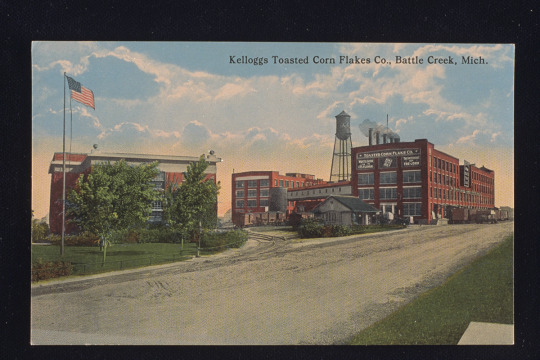
A postcard (99.146.41) of the Kellogg’s factory in 1914. THF316221 Will’s business acumen kicked in, as he embraced ever more sophisticated forms of advertising and packaging, as well as the most up-to-date machinery, factory practices, modes of communication, and distribution networks. By adding his signature to the front of each cereal box, he guaranteed the quality of his products to the public while also—once and for all—staking his claim to them. By 1909, the company was producing and shipping 120,000 cases of Corn Flakes every day!
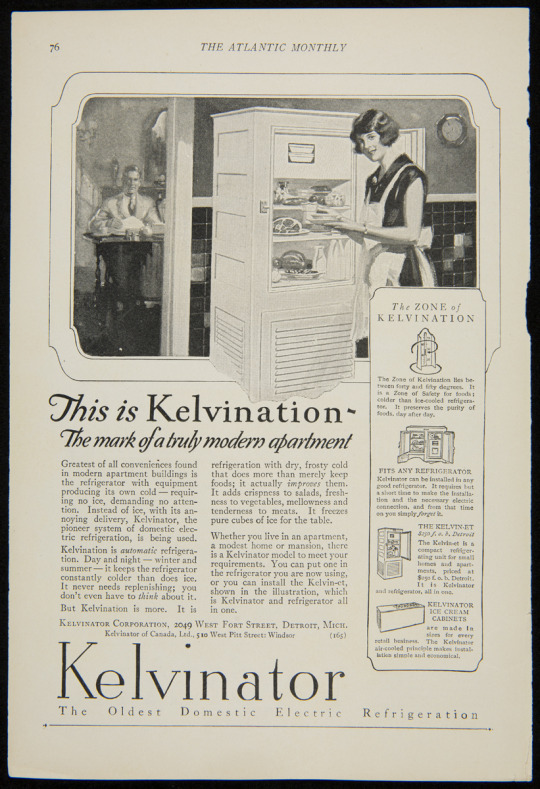
The popularity of dried cereal flakes for breakfast was in part due to improvements in both safe-to-drink milk and electric refrigerators (as shown in this 1925 ad, 2019.0.3.1) to keep the milk cold. THF290841 During Will’s active years of running the company—from 1906 to 1939—Kellogg’s became a national and ultimately global brand. These years also coincided with the growth of self-service grocery stores—in which name brand products and eye-catching packages were key to customer purchasing decisions. The success of Kellogg’s cereals was also aided by improvements in safe, pasteurized milk and the increasing popularity of electric refrigerators to keep the milk fresh.

In 1949, consumers who sent in a Kellogg’s Rice Krispies box top and 15 cents could receive this Snap! cloth doll kit (72.177.618.1). THF300027 Through Will’s leadership, the company continued to embrace new methods of advertising—cereal box coupons and giveaways, catchy jingles and character logos, colorful print ads, recipe booklets, and radio advertising. By 1939, Kellogg’s controlled over 40% of the ready-to-eat cereal business in the United States and over 50% of the business outside the U.S.
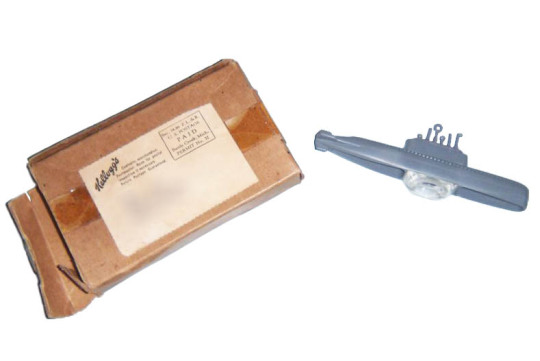
The owner of this 1950s U.S.S. Nautilus submarine toy (2015.35.47) remembered sending in 25 cents and a box top from either Kellogg’s Sugar Smacks or Sugar Corn Pops to receive it through the mail. THF183318 After Will stepped down, the company continued the aggressive marketing for which it had long been known. TV commercials and sponsorships replaced those previously on radio. Facing stiff competition from other cereal companies after World War II, Kellogg’s veered from its traditional reputation for healthful cereals and introduced a succession of sugar-loaded cereals for the new Baby Boomer market. Iconic new character logos helped promote them, like Tony the Tiger (introduced with Sugar Frosted Flakes in 1952) and Toucan Sam (introduced with Froot Loops in 1963).
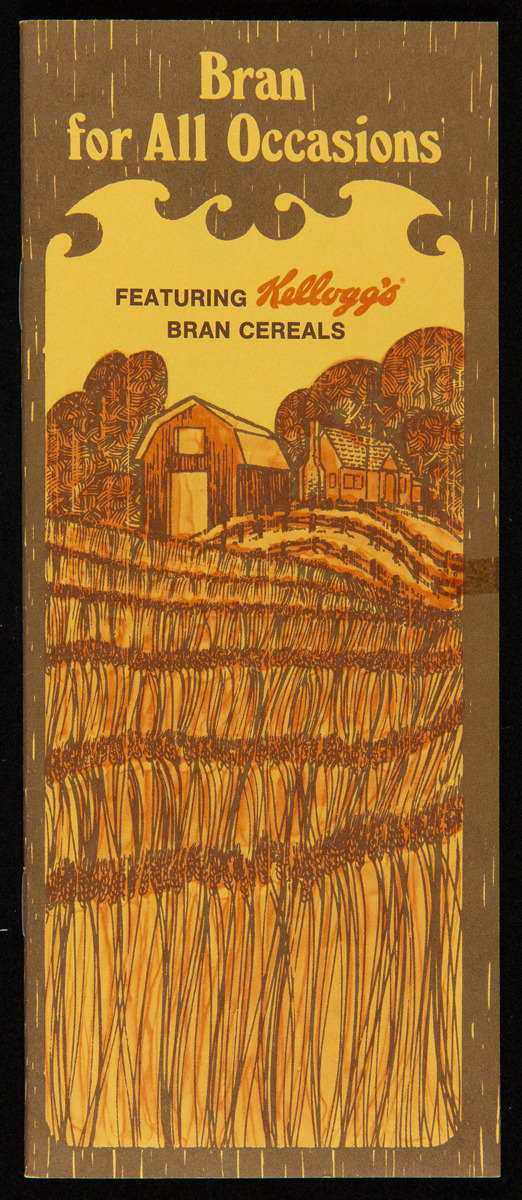
The interest in “natural foods” in the 1970s and 1980s included healthful grains that, ironically, Kellogg’s had initially promoted—like those in the bran cereals featured as ingredients in this circa 1982 recipe booklet (92.256.9). THF296229 For Kellogg’s and other cereal companies, pre-sweetened and classic cereals would dominate the market during the 1950s and 1960s. But, in 1972, following a trend toward more “natural” foods, a little-known company named Pet, Inc., achieved breakout success with its Heartland Natural Cereal. Mainstream cereal companies scrambled to introduce their own versions of “natural” cereals, including Kellogg’s contribution, Country Morning Natural Cereal (1975–80). The trend toward more healthful and nutritious cereals brought Kellogg’s full circle back to its roots and continues to be popular today.
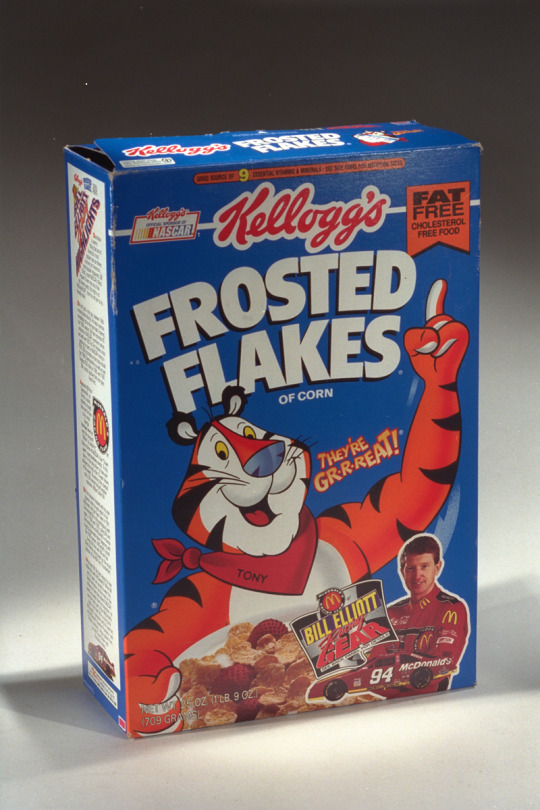
The front of this 1990s Frosted Flakes box (96.34.3.15) both features popular character logo Tony the Tiger and alludes to Kellogg’s sponsorship of NASCAR. In keeping with the times, this pre-sweetened cereal also claims to be fat-free, cholesterol-free, and include nine essential vitamins and minerals. THF302680 Too few people today recall the names of the two Kellogg brothers who started the breakfast revolution with their toasted flake cereal some 120 years ago. But it is impossible to ignore the legacy of their contribution. Through their lifetimes, Dr. J.H. Kellogg promoted healthful living, while his brother, W.K., convinced consumers that breakfast was the most important meal of the day. Meanwhile, the familiar character logos and advertising jingles for which Kellogg’s has long been famous remain in our heads and hearts. For more reading, see: The Kelloggs: The Battling Brothers of Battle Creek, by Howard Markel (2017) and The Great American Cereal Book: How Breakfast Got Its Crunch, by Marty Gitlin and Topher Ellis (2011). Donna R. Braden, Senior Curator and Curator of Public Life at The Henry Ford, fondly remembers watching all those Corn Flakes commercials when Kellogg’s sponsored her favorite pre-teen TV show, The Monkees.
#1 Ford Daily | Đại lý – Showroom ủy quyền Ford Việt Nam 2019 Ford Daily là showroom, đại lý Ford lớn nhất Việt Nam: Chuyên phân phối xe ô tô FORD như: EcoSport ✅ Everest ✅ Explorer ✅ Focus ✅ Ranger… [email protected] 6A Đường Trần Hưng Đạo, Phường Phạm Ngũ Lão, Quận 1, Hồ Chí Minh 711240 0901333373 https://forddaily.com/ https://forddaily.com/xe/ https://forddaily.com/dai-ly/ https://forddaily.com/bang-gia/ https://forddaily.com/tra-gop/ #forddaily #dailyfordhcm #fordshowroomhcm https://www.google.com/maps/place/Ford+Daily/@10.7693359,106.696211,15z/data=!4m5!3m4!1s0x0:0x1f188a05d927f4ff!8m2!3d10.7693359!4d106.696211
0 notes